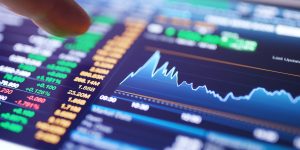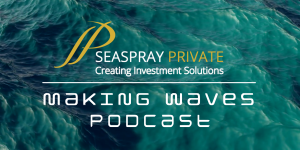Seaspray Private’s 2020 Half-Year Investment Review reflects on a period of unprecedented global challenges and market volatility. This report examines the impact of the pandemic on financial markets, highlighting areas of resilience and opportunities for recovery. With insights into key trends and strategies, our team remains focused on guiding clients through uncertain times with a steady and forward-looking approach.
Summary – 2020 Half-Year Investment Review
After an extremely volatile first quarter, in which the world underwent some massive changes in a very short period of time, not to mention the fastest 30% drawdown in the history of global equities, the global economy spent much of Q2 getting itself back on track, with the reopening of individual economies each in their own unique situation with regard to the virus. Markets, which are a forward-looking tool, have rallied on hopes for a recovery as lockdowns are steadily eased and as we begin to make the transition to the new normal. The rebound was in part helped by oversold investor sentiment along with record levels of fiscal and monetary stimulus, and with sentiment now back to a more neutral state, so is our market outlook.
We may have seen a record-breaking decline in asset values in 2020, but it is important to note that in the meantime we have witnessed the largest 50-day advance in market history during the three months up to June 30th. While we acknowledge that the initial Covid-19 contraction was larger than the great financial crisis, we believe its cumulative impact on the economy will likely be less as long as the policy response remains strong enough to cushion the blow. Normal business cycle dynamics do not apply, so for now we are tracking three main signposts:
- How successful economies are at restarting activity while controlling the virus spread
- Whether stimulus is still sufficient and reaching households and businesses
- Whether any signs of financial vulnerabilities or permanent scarring of productive capacity are emerging.
In the short to medium term we expect a U-shaped economic recovery, which means a shallow process with its ups and downs and therefore some continued volatility for now. We also think that the recovery is going to be uneven meaning every country, every company and every household is in a different financial situation which means that we need to differentiate when we pick our stocks, our sectors and our countries. But it also probably means that the recovery as a whole will be quite gradual. In addition, we believe that slower and more volatile growth favours a focus on active sub-sector and stock selection, which takes into account the transformative changes occurring across multiple axes, many of them having already been accelerated by the pandemic.
We must reiterate that we do not own the broad market, we own a heavily researched group of stocks that we have conviction in for the long term. Amid our cautiously optimistic bias, we believe at Seaspray that opportunities are continuously presenting themselves within specific asset classes in all market environments.
An event which may cause some volatility and could present us with the aforementioned longer-term opportunities is the corporate earnings season which has kicked off this week. Q2 earnings growth will arguably trough before a slow recovery in the following quarters. In the US, earnings growth rate is expected to fall by 44% when compared to Q2 of 2019, with losses anticipated in the consumer discretionary and energy sectors and profits in the industrial sector almost at zero. With most companies having withdrawn guidance during the April lockdowns, the Q2 reporting season will give investors the opportunity to get their first meaningful post-lockdown earnings guidance for this year and next. Managements are likely to stay very cautious. Investors are looking through this and expecting a rebound in the autumn as ‘normal’ life starts to come back, feeding through to 2021 earnings.
We also must reiterate to our clients that despite ongoing uncertainty, we will get back to normal. It may not happen immediately, but it will happen. Competition among nations, businesses, and everyday people to grow and enjoy life will push everyone to realise that while we do not have a vaccine in place we cannot truly stop a virus. But just like 9/11, people will fly again. They already are. They will go to restaurants again, and sporting events and theatres. But it will take time.
We remain hopeful. We have history on our side. And while risks remain for the remainder of this year, we remain bullish on equities for the long-run. Companies, like the rest of us, are adapting. They are figuring out how to limit losses, and grow, during this uncertain time. They too will emerge stronger when this storm has passed.

Equities
Markets have rallied significantly in the past few months, with equities showing major resilience, backed by stronger than expected economic data and ongoing intervention by central banks. Yet cases of coronavirus have exploded once again in the US and many states are having to reverse back into lockdown. For now, we remain cautiously optimistic in the short to medium term, and look to continue our practice of being selective about allocating cyclical stocks.
Our thoughts on European equities reflect a similar guarded optimism for a strong global recovery through the middle of 2021, and slightly less concern over frothiness in valuations as compared to North American stocks. Europe faces a number of stronger headwinds fiscally that increase downside risks, but there is room for Europe to participate in the catch-up trade through 2020 as global demand comes back online and the region is supported by the expectation for a large fiscal support package. Europe’s dependence on world trade activity can help drive the region’s bounce back as demand picks up around the globe. Bear in mind, however, that Europe was riddled with sluggish inflation and growth pre-crisis, and we expect the economic recovery to be shallower than that of the United States as we move into 2021. Having said this, we believe the search for growth opportunities will broaden out geographically as the disruptive impact of technology permeates virtually every sector, and together with the increasing focus on ESG, companies’ fundamentals will in the future become more important than where they are domiciled.
Most of the weakness in 2020 profits will come during the second quarter. That said, markets are inherently forward looking. While we acknowledge that earnings growth will improve in 2021, it seems like a V-shaped recovery will be difficult to achieve. Historically, it has taken about three years for earnings to reach a new all-time high following a drawdown. The sectoral mix of the equity market is far different from that of the economy, but it is still important to recognize the relationship between nominal GDP and earnings.
So where does this leave us? With volatility likely to remain elevated, we continue to advocate for a focus on quality with a dash of cyclicality. This means embracing sectors like health care, technology, and consumer staples, and taking advantage of underweights in highly levered sectors like energy and REITs to maintain benchmark exposure to sectors like financials. This should allow portfolios to weather the storm in the short/ medium term, while simultaneously maintaining enough cyclicality to participate when markets do rally. Our overall attitude is therefore cautiously positive towards equities, but it is important to note that we expect judicious stock selection to be key.
Risks
As noted in our investment update last month, the following risks to the global economy still remain potential causes of volatility during H2.
- Covid-19 second waves.
- US – China tensions.
- US November General Election
- December 31st Brexit deadline
In our view, the primary risk for markets remains virus-related, but we are attuned to underlying tensions that may also resurface. US-China relations have deteriorated and the likelihood of US legislation against China (e.g. equity de-listings, Hong Kong) has increased. The U.S.-China relationship is further strained since the COVID crisis, defined by greater competition and less cooperation. Bouts of market volatility are likely should tensions flare. In addition, U.S. onshoring and the likely move toward deglobalization will have margin and inflation implications down the road.
Our forecast assumes that even if virus cases rise again in certain regions, authorities will not impose a second round of lockdowns on the scale of the first. This is due to the fact that healthcare systems are better prepared than in March, experts’ understanding of virus spread has evolved and is continuing to evolve each week, and finally because the economic impact of widespread shutdowns proved harsh and non-linear.
With regard to the US General Election, we will have more ink to spill in next quarter’s outlook, but anticipation may rise steeply over the next three months and serve as a considerable headwind to the US Dollar. We must remember that a Biden presidency could see rising taxes, a climate agenda, minimum wages, and other policies hitting corporate bottom lines and the relative attractiveness of US risk-assets. A Democratic victory in November would be a significant challenge for markets given the likelihood that corporation tax cuts implemented by President Trump would be reversed. It is estimated that such a move would reduce S&P earnings in 2021 by up to 11% which would likely place the 2021 PE for the S&P 500 at almost 21 times. One of the key watchpoints in this election will be the outcome of the Republican-led U.S. Senate. Democrat control of the White House, Senate and House of Representatives would make a corporate tax hike more likely. It would also create the risk of more corporate regulation.
The other election risk is a re-escalation of the U.S./ China trade war. A recovery in the stock market and the economy provide President Trump with his best chance of re-election. We expect he will not endanger this by re-starting trade hostilities. This calculus could change if Trump’s poll ratings show him in a losing position a couple of months from the election. He may conclude that nationalism and China-bashing increase his chance for victory.
Economic uncertainty is compounded by the Brexit negotiations. There is a year-end deadline for a EU-UK trade deal, but negotiations seem to be at a stalemate. Our assumption is that a deal will be reached, but the risk of a no-deal exit, with negative consequences for trade and the economy, cannot be ignored. This has been reflected in the FTSE 100 Index, which has been the worst performer of the major developed stock indices. We like the value in the UK market on a longer-term basis. It offers a dividend yield at mid-year of 4.5% with a trailing P/E ratio of 14.5 times. Brexit uncertainty mixed in with the slow decline in virus cases could continue to hold the UK market back during Q3.
We remain somewhat cautious on markets for the remainder of the summer given the various risks outlined above and expect the recent period of range-bound trading to persist with a slightly greater risk to the downside. We do however maintain a positive outlook for markets over the medium to longer term and would favour adding aggressively to risk asset exposure on any periods of weakness that may occur over the next quarter.
Bonds
As the dynamics of the global economy and its supporting plumbing system evolve, it also makes sense to do the same with our understanding of how safe havens operate. Given the distinct possibility they may not work as they have done in the past, a little diversification between safe havens will not go amiss.
The traditional approach to building financial resilience in multi-asset portfolios has been to rely on nominal government bonds as a cushion against risk asset selloffs. One consequence of the policy revolution – bond yields tethered by central bank intervention – challenges this and forces investors to seek out alternatives. We expect negative returns across developed market government bonds on a five-year horizon given low and negative yields today. Also, the inverse correlation between bonds and stocks decreases as yields near perceived lower bounds, compromising bonds’ ballast role. The underperformance of German and Japanese bonds in recent equity sell-offs illustrates this.
No one asset can directly replace the strong and traditional role of nominal government bonds, but we believe inflation-linked bonds offer an increasingly attractive alternative. Inflationary pressures could build up once the initial deflationary shock from the sizeable demand shortfall dissipates. Deglobalization, reregulation and deficits are possible catalysts. We are of the opinion that central banks will likely tolerate temporary overshoots above inflation targets. Our bottom line: Investors need to re-evaluate nominal government bond exposures in an environment of increased deglobalization, lower-for-longer yields and unprecedented policy action. Ultra- low interest rates continue to make sovereign fixed income a very unattractive investment; selective inflation-linked securities, high yield and investment grade credit exposures are more attractive. Inflation expectations remain low and policy support mitigates deflation risks.
Monetary Policy
The U.S. fiscal stimulus packages passed since March have provided the nation’s economy with its most significant fiscal thrust since World War II. With the potential for more stimulus on the way, we are relatively positive on the U.S. economic outlook. We believe the recovery from the recession will lead to a long period of low-inflationary growth, supported by monetary and fiscal stimulus.
Equally supportive for markets has been the comfort being provided by global central banks by the fact that they stand ready to take further policy action if required to add to the already unprecedented level of liquidity support they have provided since the pandemic began back in March. This was clearly demonstrated on June 30th with Fed Chair Powell and US Treasury Secretary Mnuchin saying in their joint testimony to the House Finance Committee that further monetary and fiscal measures would be provided if and when required. Meanwhile in Europe, the ECB also indicated that it still had ample room to expand its policy support operations. Such statements of intent help explain the current resilience in markets against a very uncertain virus backdrop which has resulted in the reversal of lockdown easing measures in the US and selected regions in China, the UK and Germany.
Gold
Gold, which gained over 17%, was the top performing asset in the world in the first half of 2020, outperforming all stock markets including the S&P 500 and the Nasdaq and outperforming safe-haven US government bonds. We believe that the current environment remains extremely favourable for gold. Gold prices continue to track US real yields, the relationship is inverted. When real yields fall, gold rises. If the economy slows down, then real yields will likely fall further and that supports gold prices. If the economy is held up in suspended animation, it will be because central banks are still aggressively pumping the printing presses, undermining the value of currency, and supporting the outlook for gold. So gold is not just for a bear market. In fact, one of the key drivers of gold’s performance is the very thing that has supported risk assets and pushed US equities well beyond the previous historical rebound over such a short period of time. That is central bank and government stimulus. there is still sufficient slack in the real economy to suggest that growth remains very sluggish, or that central banks and governments will still need an even bigger bailout to keep the rebound intact. And all these would be good for gold.
Currencies
FX volatility has declined recently as economies have gone through the process of easing lockdowns. We expect volatility to subside further for as long as global monetary and fiscal policy continues to fuel confidence in markets. The dollar is likely to act as a barometer of global financial health for the time being, rising when stresses increase, falling back as they ease. The dollar typically gains during global downturns and declines in the recovery phase. The main beneficiaries of any sort of successful emergence from lockdown and return to normality over the next six months would be the economically sensitive ‘commodity currencies’, such as the Australian, New Zealand and Canadian dollars. Euro and British sterling are likely slightly undervalued at mid-year 2020. We believe the Euro will gain some ground if a second wave of the virus is avoided and a recovery is sustained. Sterling, however, is set to remain volatile around ongoing and uncertain Brexit negotiations.
The convergence of Fed policy rates to other major central banks has eroded the carry advantage of the US dollar versus other developed market currencies. With valuations priced above fair value, US dollar weakness may persist if Treasury issuances increase or the Euro area recovery fares better than expected over the next quarter.
Reasons for Caution & Optimism
The virus shock is entirely different from the normal business cycle. Global economic activity was deliberately frozen to stem the pandemic. This move led to an initial shock which was sudden and very deep. Yet what matters for asset pricing is the cumulative impact of the growth shortfall over time. History offers little insight on the path of economic reopening–or on how asset prices should react. Ahead of us is a ‘restart’ of economic activity, with many uncertainties around how quickly people and companies will feel comfortable to resume their pre-pandemic activities. The longer it takes for activity to restart, the higher the chance that more cracks may appear in the financial system and productive capacity.
Economic and market metrics are now trending in the right direction. The question is whether the market has moved too far, too fast and priced in all or most of the good news. The chart below shows the change in the S&P 500 (red line, indexed to 100 from January 2020) versus weekly jobless claims in the US (yellow bars), a key economic indicator. We see equal reasons for caution and optimism as we enter the second half of 2020. While we are unlikely to retest the March lows, the market has moved very far, very fast. It is prudent to prepare for some further bouts of volatility during Q3.

Source: BlackRock Investment Institute. Data from Refinitiv Datastream
ESG
A tectonic shift toward sustainability is poised to give a return advantage to sustainable assets for years to come – and affect all drivers of returns. In our opinion, the pandemic has supercharged a shift toward sustainability. Some assets at Environmental, Social and Governance (ESG) mandated funds in the US exceeded last year’s highs at the end of May, even as markets had sold off. Sustainable flows are still in their early stages in our view, and the sustainability wave will unfold over years and decades to come. Importantly, a return advantage may be gained during the transition to a more sustainable world. We also believe markets still underappreciate the potential economic damage caused by climate change as well as related opportunities, such as the rise in renewable energy. Extreme weather and other climate events are not yet accurately reflected in valuations. We believe these misplaced valuations are temporary, and a real opportunity lies therein.
At Seaspray, we see the ‘Social’ side of ESG capturing greater attention as the pandemic spotlights issues such as employee safety and satisfaction and forces companies to reconsider their social purpose. In fact, we see sustainability rising beyond the mere labels of environmental, social and governance. What matters is the resilience of companies to shocks, and we see sustainability becoming a core part of the investment process as a result. Our bottom line: The shift toward sustainability is not just poised to give sustainable assets a potential return advantage for years to come, but we also see it altering other return drivers and creating entirely new sources of returns.
Warning: The value of your investment may go down as well as up and you may lose some or all of the money you invest. Past performance is not a reliable guide to future performance. Investments denominated in a currency other than your base currency may be affected by changes in currency exchange rates.https://seasprayfinancialservices.ie/important-disclosures/
This material is approved for distribution in Ireland by Seaspray Financial Services Ltd .It is intended for Irish retails clients only and is not intended for distribution to, or use by, any person in any country where such distribution or use would be contrary to local law or regulation. Seaspray Financial Services Ltd Ire (“SFS”) is regulated by the Central Bank of Ireland.
Where SFS wishes to make this and other Seaspray Financial Services Ltd research available to Retail clients, such information is provided without liability and in accordance with our terms and conditions that are available on the SFS website.
No report is intended to and does not constitute a personal recommendations or investment advice, nor does it provide the sole basis for any evaluation of the securities that may be the subject matter of the report. Specifically, the information contained in this report should not be taken as an offer or solicitation of investment advice, or to encourage the purchased or sale of any particular security. Not all recommendations are necessarily suitable for all investors and SFS recommend that specific advice should always be sought prior to investment, based on the particular circumstances of the investor either from your SFS investment adviser or another investment adviser.
SFS takes all responsibility to ensure that reasonable efforts are made to present accurate information but SFS gives no warranty or guarantee as to, and do not accept responsibility for, the correctness, completeness, timeliness or accuracy of the information provided or its transmission. This is entirely at the risk of the recipient of the report. Nor shall SFS, its subsidiaries, affiliates or parent company or any of their employees, directors or agents, be liable to for any losses, damages, costs, claims, demands or expenses of any kind whatsoever, whether direct or indirect, suffered or incurred in consequence of any use of, or reliance upon, the information. Any person acting on the information contained in this report does so entirely at his or her own risk
All estimates, views and opinions included in this research note constitute Seaspray Financial Services judgment as of the date of the note but may be subject to change without notice. Changes to assumptions may have a material impact on any recommendations made herein.
Unless specifically indicated to the contrary this research note has not been disclosed to the covered issuer(s) in advance of publication.
Past performance is not a reliable guide to future performance. The value of your investment may go down as well as up. Investments denominated in foreign currencies are subject to fluctuations in exchange rates, which may have an adverse affect on the value of the investments, sale proceeds, and on dividend or interest income. The income you get from your investment may go down as well as up. Figures quoted are estimates only; they are not a reliable guide to the future performance of this investment.
Conflicts of Interest & Share Ownership Policy
It is noted that research analysts’ compensation is impacted upon by overall firm profitability and accordingly may be affect ed to some extent by revenues arising other Seaspray Financial Services Ltd business units including Investment Management and Corporate Finance. Revenues in these business units may derive in part from the recommendations or views in this report. Notwithstanding, Seaspray Financial Services Ltd is satisfied that the objectivity of views and recommendations contained in this note has not been compromised. Nonetheless Seaspray Financial Services Ltd is satisfied that the impartiality of research, views and recommendations remains assured.
Analyst Certification
Each research analyst responsible for the content of this research note, in whole or in part, certifies that: (1) all of the views expressed accurately reflect his or her personal views about those securities or issuers; and (2) no part of his or her compensation was, is, or will be, directly or indirectly, related to the specific recommendations or views expressed by that research analyst in the research note.
We have assessed the publication and have classed it as Research under MIFID II. All charges in relation to this publication will be borne by Seaspray Financial Services Ltd.







